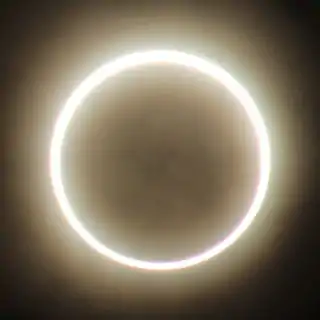Solar eclipse of June 29, 1927
A total solar eclipse occurred on June 29, 1927. A solar eclipse occurs when the Moon passes between Earth and the Sun, thereby totally or partly obscuring the image of the Sun for a viewer on Earth. A total solar eclipse occurs when the Moon's apparent diameter is larger than the Sun's, blocking all direct sunlight, turning day into darkness. Totality occurs in a narrow path across Earth's surface, with the partial solar eclipse visible over a surrounding region thousands of kilometres wide. The path of totality crossed far northern Europe and Asia, including the United Kingdom, Norway, Sweden, Finland and Soviet Union (today's Russia) on June 29th (Wednesday), and finally passed Amukta in Alaska on June 28th (Tuesday). This was the first total eclipse visible from British mainland soil for 203 years. This eclipse is referenced in the closing pages of Dorothy L. Sayers' novel Unnatural Death.[1]
| Solar eclipse of June 29, 1927 | |
|---|---|
 Map | |
| Type of eclipse | |
| Nature | Total |
| Gamma | 0.8163 |
| Magnitude | 1.0128 |
| Maximum eclipse | |
| Duration | 50 sec (0 m 50 s) |
| Coordinates | 78.1°N 73.8°E |
| Max. width of band | 77 km (48 mi) |
| Times (UTC) | |
| Greatest eclipse | 6:23:27 |
| References | |
| Saros | 145 (17 of 77) |
| Catalog # (SE5000) | 9344 |
Related eclipses
Solar eclipses 1924–1928
This eclipse is a member of a semester series. An eclipse in a semester series of solar eclipses repeats approximately every 177 days and 4 hours (a semester) at alternating nodes of the Moon's orbit.[2]
| Solar eclipse series sets from 1924–1928 | ||||
|---|---|---|---|---|
| Ascending node | Descending node | |||
| 115 | July 31, 1924 Partial |
120 | January 24, 1925 Total | |
| 125 | July 20, 1925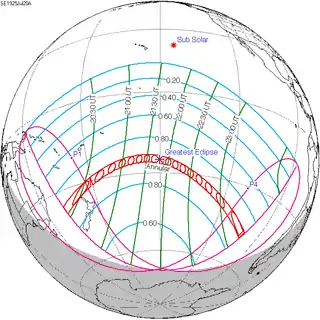 Annular |
130 | January 14, 1926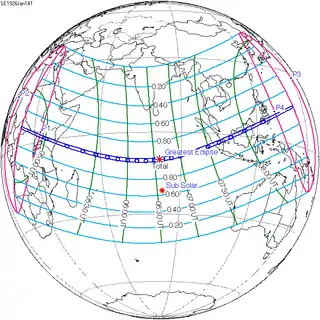 Total | |
| 135 | July 9, 1926 Annular |
140 | January 3, 1927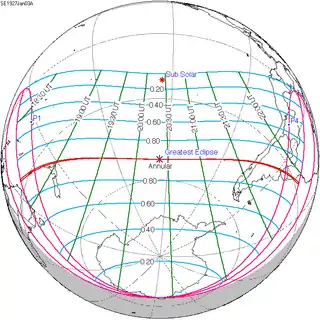 Annular | |
| 145 | June 29, 1927 Total |
150 | December 24, 1927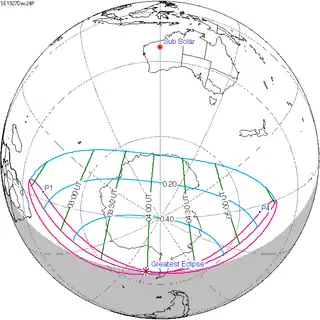 Partial | |
| 155 | June 17, 1928 Partial | |||
Saros 145
This solar eclipse is a part of Saros cycle 145, repeating every 18 years, 11 days, 8 hours, containing 77 events. The series started with a partial solar eclipse on January 4, 1639, and reached a first annular eclipse on June 6, 1891. It was a hybrid event on June 17, 1909, and total eclipses from June 29, 1927, through September 9, 2648. The series ends at member 77 as a partial eclipse on April 17, 3009. The longest eclipse will occur on June 25, 2522, with a maximum duration of totality of 7 minutes, 12 seconds. All eclipses in this series occurs at the Moon's ascending node.
| Series members 10–32 occur between 1801 and 2359 | ||
|---|---|---|
| 10 | 11 | 12 |
 April 13, 1801 |
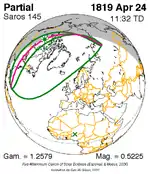 April 24, 1819 |
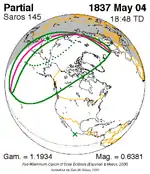 May 4, 1837 |
| 13 | 14 | 15 |
 May 16, 1855 |
 May 26, 1873 |
 June 6, 1891 |
| 16 | 17 | 18 |
 June 17, 1909 |
 June 29, 1927 |
 July 9, 1945 |
| 19 | 20 | 21 |
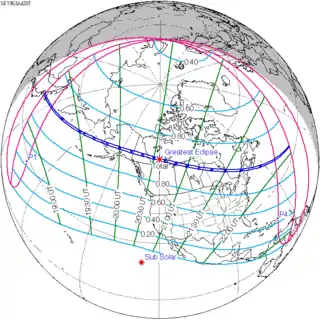 July 20, 1963 |
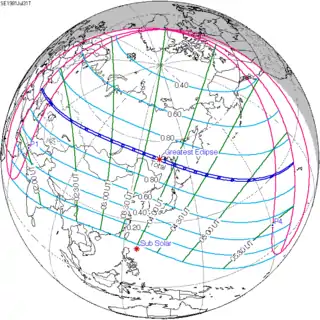 July 31, 1981 |
 August 11, 1999 |
| 22 | 23 | 24 |
 August 21, 2017 |
 September 2, 2035 |
 September 12, 2053 |
| 25 | 26 | 27 |
 September 23, 2071 |
 October 4, 2089 |
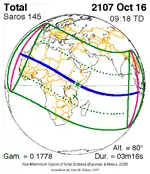 October 16, 2107 |
| 28 | 29 | 30 |
 October 26, 2125 |
 November 7, 2143 |
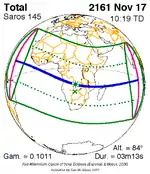 November 17, 2161 |
| 31 | 32 | 33 |
 November 28, 2179 |
 December 9, 2197 |
 December 21, 2215 |
| 34 | 35 | 36 |
 December 31, 2233 |
 January 12, 2252 |
 January 22, 2270 |
| 37 | 38 | 39 |
 February 2, 2288 |
 February 14, 2306 |
 February 25, 2324 |
| 40 | ||
 March 8, 2342 | ||
See also
Notes
- https://www.fadedpage.com/showbook.php?pid=20181241
- van Gent, R.H. "Solar- and Lunar-Eclipse Predictions from Antiquity to the Present". A Catalogue of Eclipse Cycles. Utrecht University. Retrieved 6 October 2018.
.jpg.webp)
